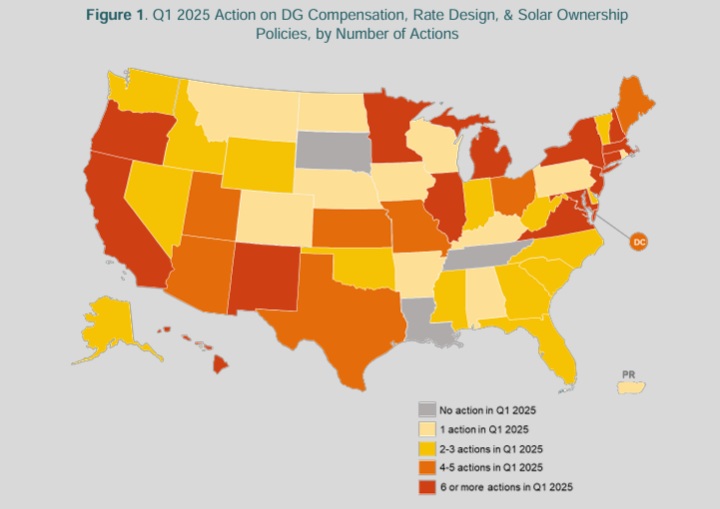The recent 50 States of Solar report from NC Clean Energy Technology Center identifies three trends in state policy activities and the top five distributed solar actions in Q1 2025.
The NC Clean Energy Technology Center (NCCETC) released its 50 States of Solar Q1 2025 quarterly report, which finds many states considering “new major revisions” to net metering policy, changes in distributed solar valuation, interconnection rules, community solar, residential fixed charges, residential demand and solar charges, and third-party ownership.
This quarter, the report also looks at interconnection guidelines, fees, and requirements for distributed generation systems. It also adds a focus on solar incentives like rebate, grant, loan, and SREC programs, along with various tax credits, exemptions, and deductions.
Q1 was a busy quarter for solar policy, with the report finding a total of 193 distributed solar policy actions were taken, with the most actions taken in Virginia, Minnesota, New Jersey, New York, Connecticut, Michigan, and New Hampshire. Some kind of solar policy action was taken in 47 states, plus the District of Columbia and Puerto Rico, (see figure below), with the greatest number of actions continuing to address net metering policies (55), community solar policies (35), and residential fixed charge or minimum bill increases (34).

The three trends spotted include:
- States considering iterative revisions to net metering policies;
- States overhauling community solar programs;
- States expanding system size limits for non-residential net metered systems.
Moves by utilities and regulators are noted in the report’s top five distributed solar policy actions of Q1 2025:
- Nevada Power and Sierra Power filing net metering successor tariffs with Nevada regulators;
- Rocky Mountain Power requesting approval for a new export credit rate in Idaho;
- Maryland regulators approving rules for a permanent community solar program;
- El Paso Electric in Texas proposing distributed generation customers shift from a minimum bill to a demand charge; and
- Illinois regulators releasing the final version of its Value of Distributed Energy Resources Report.
Net metering
Revision to net metering is a key trend, as the report finds that about one-third of the states are either offering alternatives to traditional net metering or making significant revisions. Net energy metering is the process by which utilities offer solar owners credit on electric bills for excess energy sent to the grid.
“Now, some of these states are investigating new major revisions – successors to their successors, so to speak,” observed Rebekah de la Mora, senior policy analyst at NCCETC. “Some of these reviews were mandated through legislative authority, while others were brought forward by utility regulators, or even utilities themselves.”
California is a case in point where the sudden slash of about 80% of net metering value led to an 80% drop in installations in the following months. The Q1 report finds that California regulators are considering further revisions to the virtual net metering program for government and institutional customers, as well as net metering programs at smaller investor-owned utilities.
The Arizona Corporation Commission is reviewing its limit on annual changes to the avoided cost proxy credit rate, with Commission Staff recommending continuing the 10% annual limit. A pv magazine USA article noted that the Arizona Commission justified the charge based on an argument that rooftop solar customers create a cost shift on non-solar customers, making electricity service more expensive for those who have not installed solar panels on their roof.
Connecticut regulators began a legislatively mandated review into the Renewable Energy Solutions Program, the state’s successor net metering program that began in 2022.
Two utilities in Nevada filed tariffs to move from monthly netting to 15-minute netting for systems under 25 kW, after various revisions over the past several years.
Community solar
NCCETC reports that community solar-enabling policies are currently established in 25 states, and notes that in many states, policymakers have begun revamping their programs. Community solar offers ratepayers access to solar-generated electricity without having to put solar on their rooftops. By subscribing to a portion of the electricity generated by a local community solar installation, renters who don’t own their rooftops or people who can’t afford the upfront cost of solar have access to clean and low-cost electricity.
“This quarter, regulators around the country took action to implement iterations on community solar programs within their jurisdictions. Many of these iterations were driven by recently enacted legislation,” noted Vincent Potter, project manager at NCCETC. “Some programs are shifting from pilots to permanent programs, while others are moving towards program designs focused on low-income customer participation.”
According to the National Renewable Energy Laboratory, a substantial fraction of the national rooftop solar potential is located on low- and moderate-income buildings and, for all incomes, a substantial fraction is located on multi-family and renter-occupied buildings.
Several state policy moves noted in the Q1 report focus on making community solar policies more inclusive. In Colorado, for example, the Colorado Public Utilities Commission began regulatory proceedings to implement the state’s new inclusive community solar program that would replace the existing community solar gardens program.
In other states, existing pilots are moving toward permanent programs. Maryland regulators, for example, approved rules for its permanent community solar program, to succeed its community solar pilot.
Size limits are being expanded for non-residential net metered community solar customers in some states. The Delaware Public Service Commission approved various changes to net metering regulations, including increasing the system size limit for farm customer-generators from 100 kW to 150 kW. In Idaho, Rocky Mountain Power is requesting approval to increase the maximum system size for non-residential customers from 100 kW to 2 GW. Minnesota regulators opened a rulemaking to amend the definition of system size “capacity”. The New Hampshire Senate passed a bill establishing a new customer class of “industrial hosts” for large customer-generators with systems between 1 MW and 5 MW.


